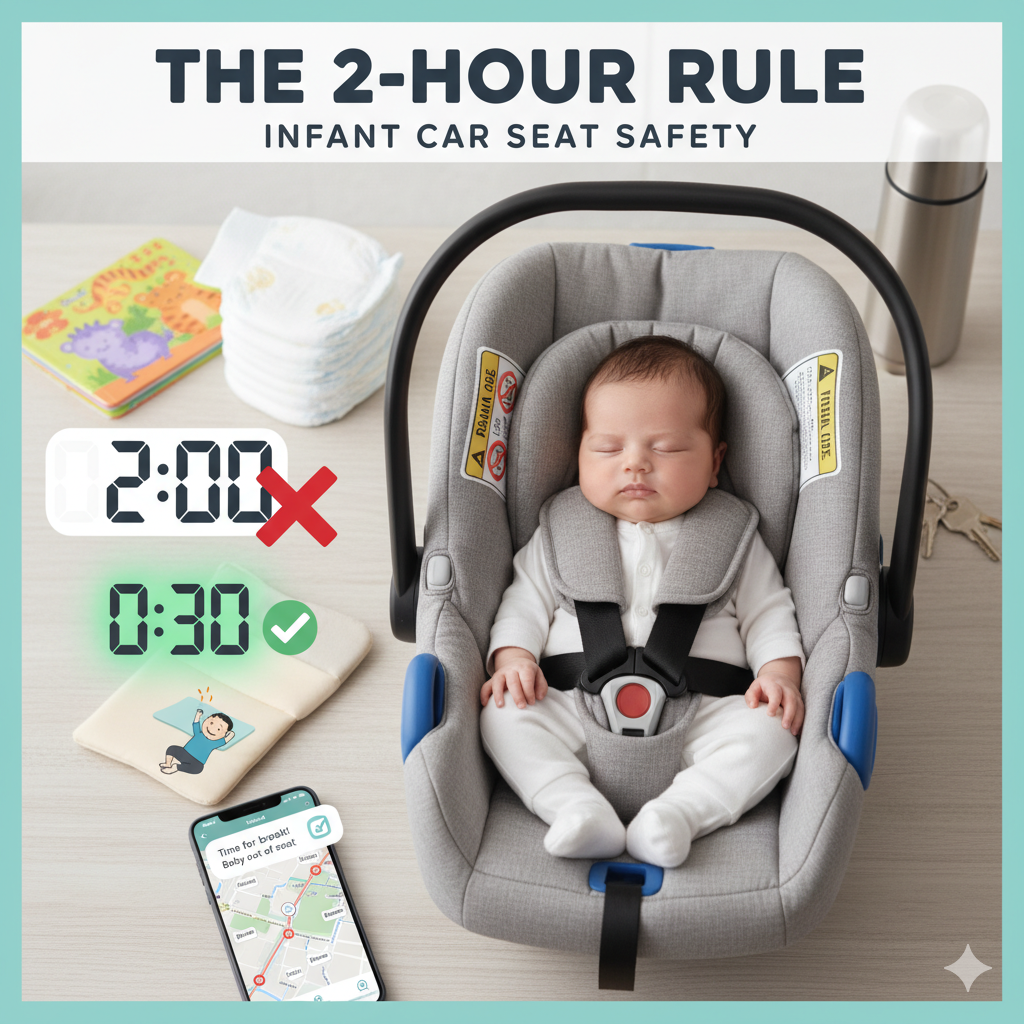The 2-Hour Rule: How Long Can Your Infant Safely Stay in a Car Seat?
The convenience of an infant car seat is undeniable. From carrying a sleeping baby straight from the car into the house to snapping it into a compatible stroller as part of a travel system, these tools simplify life for new parents.
However, as a safety device, the car seat is designed specifically for transport, not for extended sleep or resting. As you plan your first road trips or even navigate a day of errands, the question is crucial: How long can an infant stay in an infant car seat?
The answer, supported by pediatric and car seat safety experts, is clear and non-negotiable, particularly for newborns: The 2-Hour Rule.
Understanding the Golden Standard: The 2-Hour Rule (And Why It Matters)

The universally accepted guideline for infant car seat use is known as The 2-Hour Rule. This means that babies should not spend more than two consecutive hours in their car seat, whether it’s in a moving vehicle, clicked into a stroller, or used as a temporary napper indoors.
Once the two hours are up, you must take your baby out, lay them flat, and allow them to stretch and reposition for at least 15 to 30 minutes before returning them to the seat (if travel must continue).
Why the Strict 2-Hour Limit?
This time limit isn't arbitrary; it is based on two primary safety and developmental concerns that directly impact your infant's health.
1. The Risk of Positional Asphyxia

This is the most critical concern, especially for premature babies and those under four weeks old.
The angle of a car seat, while necessary for crash protection, places a newborn in a semi-reclined position. In this position, the baby's head can naturally slump forward, pushing their chin to their chest. Because an infant's neck muscles are weak, they cannot easily correct this position.
When the chin is tucked to the chest, it can compress their soft airway and restrict oxygen flow, leading to a condition called positional asphyxia. This significantly reduces oxygen saturation and can happen silently, making constant supervision essential.
Safety Tip: Always ensure the car seat harness is tight enough (you should not be able to pinch any slack at the shoulder) and that the chest clip is placed level with the baby’s armpits to keep them secured in the safest, most upright position possible for the seat.
2. Developmental Risk: Plagiocephaly (Flat Head Syndrome)

While not immediately life-threatening, extended periods of time resting against the hard shell of a car seat can contribute to plagiocephaly, or flat head syndrome.
Infant skulls are soft and malleable. When pressure is consistently applied to one area of the skull (like the back of the head against the car seat liner), it can lead to a flattening of that area. The 2-hour rule ensures that the baby receives regular breaks for:
-
Repositioning: Allowing them to move freely.
-
Tummy Time: The essential counter-activity to all time spent on their back.
Long Road Trips: Practical Tips for Breaking the Cycle

If you are planning a trip longer than two hours, preparation is key to adhering to the safety guidelines:
|
Activity |
Recommended Timing |
Purpose |
|---|---|---|
|
Scheduled Stops |
Every 1.5 to 2 hours |
Adhere to the 2-Hour Rule and prevent driver fatigue. |
|
Car Seat Break |
15–30 minutes at each stop |
Crucial: Take the baby completely out of the seat and hold them upright or lay them flat. |
|
Tummy Time |
5–10 minutes during the break |
Helps relieve pressure on the back of the head and strengthens neck muscles. |
|
Feed and Diaper |
Use the car seat break time for all necessary baby care. |
Maximizes the time outside of the restraint system. |
Remember, a car seat is not a substitute for a crib or bassinet. If your baby falls asleep on a long journey, you must still stop and remove them after the two-hour limit.
When Does the Car Seat Rule Change?
The 2-hour rule is most critical during the newborn stage (0-4 weeks), but the principle applies until the child transitions out of a rear-facing-only infant car seat (typically around 9–12 months or when they hit the seat’s height or weight limit).
Once your child moves into a convertible car seat that can be installed rear-facing, the design often allows for a slightly better recline angle and more seating support than a portable infant carrier. However, even in a convertible seat, pediatricians still advise limiting continuous seated time to 2-3 hours to prevent discomfort, stiffness, and ensure proper circulation.
The Key Takeaway: Whether you’re using a standard infant carrier or a feature-rich convertible seat, never treat the car seat as a long-term resting place. Safety demands frequent, scheduled breaks.

Disclaimer: Always consult your car seat manufacturer’s manual for specific instructions regarding weight, height, and safe use limits for your particular model.





